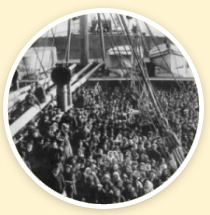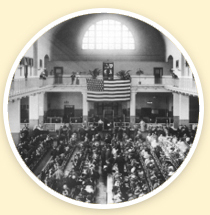Empowering a new generation of Americans
You are here
"Mother of Exiles"
The New Colossus
.png)
"Not like the brazen giant of Greek fame, With conquering limbs astride from land to land; Here at our sea-washed, sunset gates shall stand A mighty woman with a torch, whose flame Is the imprisoned lightning, and her name Mother of Exiles. From her beacon-hand Glows world-wide welcome; her mild eyes command The air-bridged harbor that twin cities frame.
Keep, ancient lands, your storied pomp!" cries she With silent lips. "Give me your tired, your poor, Your huddled masses yearning to breathe free, The wretched refuse of your teeming shore. Send these, the homeless, tempest-tost to me, I lift my lamp beside the golden door!" -
Emma Lazarus, 1883
Jeffrey Garcia a Center for Working Families client holds the "Mother of Exiles" painting by Ken Brown which inspired HUF's Immigration Exhibit also by that name. The title "Mother of Exiles" is taken from the first stanza of Emma Lazarus' poem engraved on the Statue of Liberty.
Below is information taken from HUF's Immigration Exhibit. In addition to the artwork, Ken also helped to research the project. The final exhibit was written, designed and curated by Michael Farver.
Visitors are wlecomed to sign up to our virtual Empowerment Tour and further discuss the installation.
Coming to America:
U.S. Immigration 1600-1945
The First Americans
It has long been a topic of debate and discussion as to just who got to America first. Today, the great American melting pot of peoples and cultures only heightens the intensity of such a debate.
We do know the history of US immigration spans a long period of migration of many different peoples from various parts of the world. And we can identify that our earliest European settlers started in Florida. St. Augustine was founded in 1565 by Spain, more than 42 years before the English colonized Jamestown and over 55 years before the pilgrims landed at Plymouth Rock.
1600-1800
 From 1600 to 1800, over half of all Europeans arrived in the United States as indentured servants. They paid for their passage by work contracts.
From 1600 to 1800, over half of all Europeans arrived in the United States as indentured servants. They paid for their passage by work contracts.
In 1783, President George Washington stated: "The bosom of America is open to receive not only the opulent and respectable stranger, but the oppressed and persecuted of all nations and religions."
1808
The United States trade in foreign slaves became illegal. The 50,000 slaves smuggled into the country after 1808 became our first illegal immigrants.
The continuous presence of persons of African descent on soil that became the United States begins in 1619 with the arrival of twenty Africans at Jamestown, Virginia, aboard a Dutch warship from the West Indies.
The authors of the Constitution protected the foreign slave trade, a major source of immigration, by prohibiting interference with it for twenty years (Article 1, Section 9). When that period expired, Congress, at President Jefferson's invitation, promptly made that trade illegal, but did not interfere with either the domestic slave trade or slavery itself. The approximately 50,000 slaves smuggled into the United States after 1808 became the first illegal immigrants.
1849
The U.S. Supreme Court RulesthatCongress alone can regulate immigration.
About 10,000 Hispanics fought in the Civil War. 200,000 (primarily Mexican Americans) were mobilized for WWI. And 500,000 Hispanics served the U.S. during WWII.
1882
 The Chinese Exclusion Act Passes. It was the first immigration act withrestrictions specifically designated for a particular group.
The Chinese Exclusion Act Passes. It was the first immigration act withrestrictions specifically designated for a particular group.
On May 6, 1882, the Chinese Exclusion Act Passed, and the immigration “Exclusion Era” began. It was the first act that restricted immigration specifically designated for a particular group. The Chinese Exclusion Act was the result of California workers complaining about the large numbers of immigrants coming from China. It marked the moment when the golden doorway of admission to the United States began to narrow and initiated a thirty-nine-year period of successive exclusions of certain kinds of immigrants,
The Chinese Exclusion Act worked. In 1882, before it took effect, over 39,000 Chinese came to America. In 1887, Chinese immigration bottomed out at 10. While America’s population more than doubled between 1880 and 1920, the population of Chinese ancestry declined by over a third."
In 1886, the Statue of Liberty, on Bedloe's Island, was dedicated as a gift of the French nation to the American people and as a symbol of their eternal friendship.
1898
The Supreme Court confirms that 14th amendment gives citizenship to all persons born in the United States
In 1890, Congress appropriated the sum of $75,000 to build the 1st Federal Immigration Station on Ellis Island. Landfill from incoming ships' ballast and New York City subway tunnels doubled the size of Ellis to over six acres. While the new immigration station was being constructed, the Barge Office, located at “The Battery” on the tip of Manhattan, was used for immigration reception.
Ellis Island
On January 1st, 1892, the first Ellis Island Immigration Station officially opened. The first immigrant to pass through Ellis was a "rosy-cheeked Irish girl," Annie Moore, age 15, from County Cork. She came with her two younger brothers to join their parents in New York City. That first day, three large ships were waiting to land, and 700 immigrants passed through.

Boat filled with European immigrants arrives at Ellis Island

The main hall at Ellis Island which processed
more than 12 million immigrants from 1892-1954
1900’s
From 1892 to 1954, over twelve million immigrants entered the United States through the portal of Ellis Island, a small island in New York Harbor.
1910
The chaos of the Mexican Revolution drove thousands across the U.S./Mexican border to seek jobs in railroads, mining & agriculture.
Beyond physical proximity, the United States offered jobs — in industry, in mines, on railroads, and in agriculture — and all at wage levels far higher than those in Mexico. World War I further increased the demand for Mexican labor."
1917
The Immigration Act of 1917 denies entry to immigrants from eastern Asia and the Pacific Islands.
The Act denied entry to immigrants from the 'Asiatic Barred Zone'--much of eastern Asia and the Pacific Islands. It also set a literacy requirement for immigrants over 16 and a head tax for entry into the country; it barred entry by 'idiots,' 'feeble-minded persons,' 'epileptics,' 'insane persons,' alcoholics, 'professional beggars,' all persons 'mentally or physically defective,' polygamists, and anarchists."
In 1921, Congress put a temporary quota on immigration. The quota was made permanent in 1924. It limited the total number of immigrants to 164,000 each year.
In 1921, Congress put a temporary quota on immigration. It was the first of the quota or percentage laws passed. It was sponsored by the American Legion and American Federation of Labor, and became law over Wilson's veto... It limited the number of immigrants who could enter this country from Europe, Australia, Africa, New Zealand, Asiatic Turkey, Persia, and certain islands of the Atlantic and Pacific oceans to 3 percent of the number of foreign-born of such nationalities residing here when the 1910 census was taken.
In 1924, Congress made the quota permanent and more strict. It limited the total number of immigrants to 164,000 each year. It also fixed quotas on immigration from each country, basing the quota on the percentage of people from that country who lived in the United States in 1890. Since the population in 1890 was overwhelmingly from Northern Europe, the law favored immigration from Northern Europe and discouraged immigration from other countries.
1924
Congress passes the Labor Appropriation Act of 1924, officially establishing the U.S. Border Patrol for the purpose of securing the borders between inspection stations.
In 1925 its duties were expanded to patrol the seacoast.
From 1929 to 1939, as many as one million people of Mexican descent were forced or pressured to leave the U.S. This “Mexican Repatriation” by the Immigration & Naturalization Service targeted Mexicans due to "the proximity of the Mexican border, the physical distinctiveness of mestizos, and the easily identifiable barrios."
The Mexican Repatriation refers to a forced migration that took place between 1929 and 1939, when as many as one million people of Mexican descent were forced or pressured to leave the US. The event, carried out by American authorities, took place without due process. The Immigration and Naturalization Service targeted Mexicans because of "the proximity of the Mexican border, the physical distinctiveness of mestizos, and easily identifiable barrios."
“Voyage of the Damned”

 In May-June 1939, the United States refused to admit Jewish refugees who, fleeing Nazi persecution had sailed from Hamburg, Germany, on the MS St. Louis. Denied permission to land by Cuba, the U.S and Canada, the ship was forced to return to Europe, where the passengers found asylum in England, France, Belgium and the Netherlands. Of the original 936 refugees, nearly 250 were eventually killed during WWII.
In May-June 1939, the United States refused to admit Jewish refugees who, fleeing Nazi persecution had sailed from Hamburg, Germany, on the MS St. Louis. Denied permission to land by Cuba, the U.S and Canada, the ship was forced to return to Europe, where the passengers found asylum in England, France, Belgium and the Netherlands. Of the original 936 refugees, nearly 250 were eventually killed during WWII.
In a highly publicized event that took place in May-June 1939, the United States refused to admit over 900 Jewish refugees who had sailed from Hamburg, Germany, on the MS St. Louis. She sailed from Hamburg to Cuba on May 13, 1939, carrying seven non-Jewish and 930 Jewish refugees (mainly German) seeking asylum from Nazi persecution.[2][3] On the ship’s arrival in Cuba, the Cuban government under Federico Laredo Brú refused the passengers entry as either tourists (laws related to tourist visas had recently been changed) or under political asylum. The St. Louis appeared off the coast of Florida shortly after Cuban authorities cancelled the refugees' transit visas and denied entry to most of the passengers, who were still waiting to receive visas to enter the United States. Denied permission to land in the United States, the ship was forced to return to Europe. The passengers found asylum in England, France, Belgium and the Netherlands. Of the original 936 refugees, nearly 250 were eventually killed during WWII.
1942
U.S. President Franklin D. Roosevelt signs Executive Order 9066 sending tens of thousands of Japanese Americans (among others) to internment camps.
1945
War Brides and Fiancées Acts allow an estimated 1,000,000 American soldiers to bring their foreign spouses to America.
Laws
Significant U.S. Immigration Legislation
- 1790 Naturalization Act of 1790: Stipulated that "any alien, being a free white person, may be admitted to become a citizen of the United States."
- 1875: Supreme Court declared that regulation of U.S. immigration the Federal Governments responsibility.
- 1882 The Chinese Exclusion Act: Prohibited certain laborers from immigrating to the United States.
- 1885 and 1887: Alien Contract Labor laws which prohibited certain laborers from immigrating to the United States.
- 1891: The U.S. Government assumed the task of inspecting, admitting, rejecting, and processing all immigrants seeking admission to the U.S.
- 1892: On January 1st, a new Federal U.S. immigration Station opened on Ellis Island in New York Harbor.
- 1903: This Act restated the 1891 provisions concerning land borders and called for rules covering entry as well as inspection of aliens crossing the Mexican border.
- 1907 The US immigration Act of 1907: Reorganized the states bordering Mexico (Arizona, New Mexico and a large part of Texas) into the Mexican Border District to stem the flow of immigrants into the United States.
- 1917-1924: A series of laws were enacted to further limit the number of new immigrants. They established the quota system and imposed passport requirements. They expanded the categories of excludable aliens and banned all Asians except Japanese.
- 1924 Act: Reduced the number of U.S. immigration visas and allocated them on the basis of national origin.
- 1940 The Alien Registration Act: Required all aliens (non- U.S. citizens) within the United States to register with the Government and receive an Alien Registration Receipt Card (the predecessor of the "Green Card").
- 1950 Passage of the Internal Security Act: Rendered the Alien Registration Receipt Card even more valuable. Immigrants with legal status had their cards replaced with what became known as the "green card" (Form I-151).
Sources of U.S. Immigration
The sources of U. S. immigration have changed a number of times over the years.
Before 1881, the vast majority of immigrants, nearly 86% of the total, arrived from northwest Europe, principally Great Britain, Ireland, Germany, and Scandinavia.
During the colonial period, most immigrants arrived from Britain, with smaller numbers coming from Ireland and Germany.
After 1881, the immigrant volume from central, eastern, and southern Europe began to increase rapidly.
Between 1894 and 1914, immigrants from southern, central, and eastern Europe accounted for 69% of the total.
With the onset of World War I in 1914, the sources of U.S. immigration again changed. Beginning in 1915, the major source of immigrants to the U.S. became the Western Hemisphere, accounting for 46% of the total.
In the period between 1915 and 1950, virtually all of the remaining immigrants came from Europe, though no specific part of Europe was dominant.
Immigration to the United States by Decade: 1820-1950
| Decade | Number of Immigrants |
| 1820-1830 | 143,439 |
| 1830-1840 | 599,125 |
| 1840-1850 | 1,713,251 |
| 1850-1860 | 2,598,214 |
| 1860-1870 | 2,314,824 |
| 1870-1880 | 2,812,191 |
| 1880-1890 | 5,246,613 |
| 1890-1900 | 3,687,564 |
| 1900-1910 | 8,795,386 |
| 1910-1920 | 5,735,811 |
| 1920-1930 | 4,107,209 |
| 1930-1940 | 528,431 |
| 1940-1950 | 1,035,039 |
Source: 2001 Statistical Yearbook of the Immigration and Naturalization Service
Further Reading
For an excellent brief history of US immigration and policy read the Immigration Policy Center’s article:





